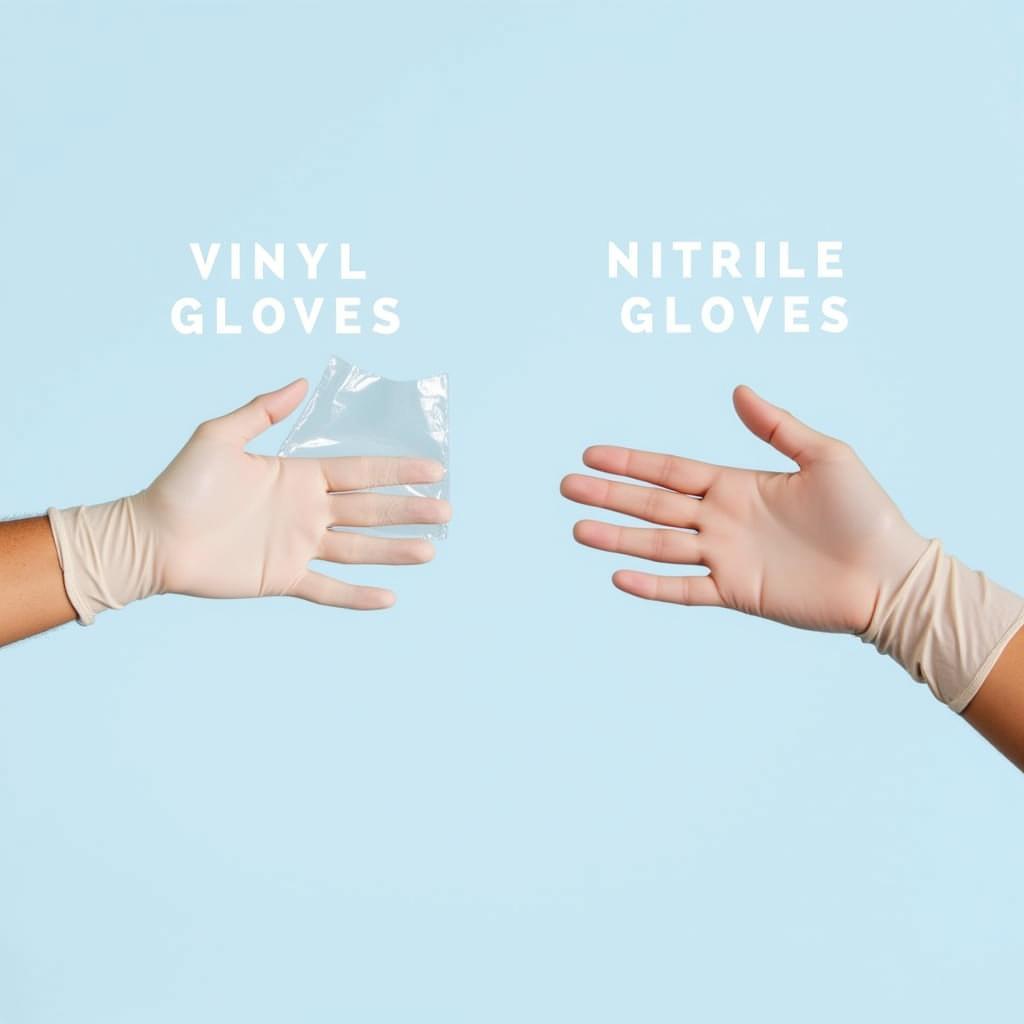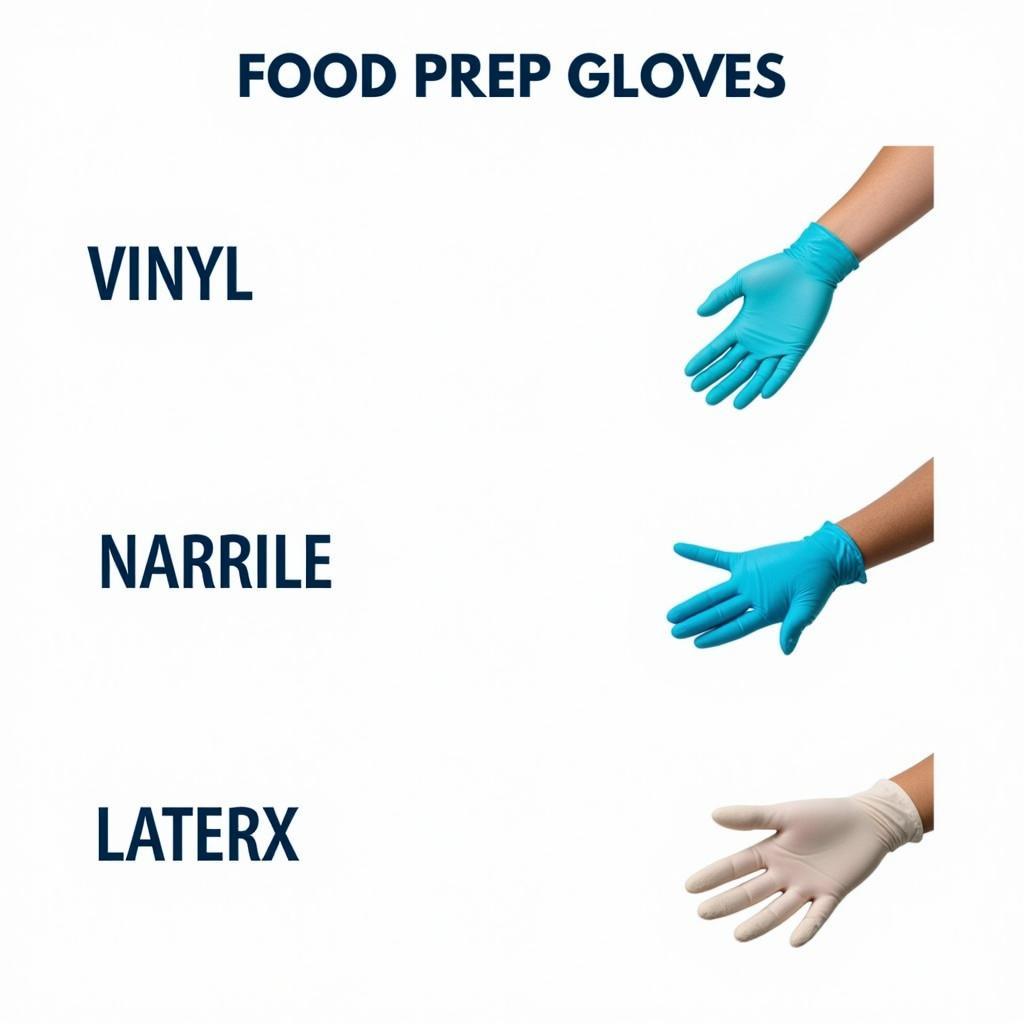Finding the Best Gloves For Food Prep is crucial for maintaining hygiene and ensuring food safety. Whether you’re a professional chef or a home cook, the right gloves can protect you and your food from cross-contamination, while also providing comfort and dexterity. This guide will delve into the different types of gloves available, helping you make an informed decision for your culinary needs. After this, you’ll be well on your way to safer and more efficient food handling. Want to know more about specialized tools for food processing? Check out this food saw.
Types of Food Prep Gloves
Choosing the right food prep gloves can feel overwhelming with so many options on the market. Let’s break down the most common types to help simplify your decision.
Vinyl Gloves
Vinyl gloves are a popular choice due to their affordability and ease of use. They’re suitable for low-risk tasks like handling ready-to-eat foods or preparing salads. However, they offer less durability and puncture resistance than other options. They’re also not ideal for handling greasy or oily foods.
Nitrile Gloves
Nitrile gloves are known for their superior puncture resistance, durability, and resistance to chemicals and oils. They’re a great all-around choice for most food prep tasks, from handling raw meats to chopping vegetables. Nitrile gloves are also latex-free, making them a safe option for those with allergies.
Latex Gloves
Latex gloves offer excellent dexterity and a snug fit, providing good tactile sensitivity. However, due to the potential for latex allergies, they’re becoming less common in professional kitchens. If you choose latex gloves, ensure everyone handling food isn’t allergic.
Polyethylene Gloves
Often referred to as “disposable gloves,” polyethylene gloves are a lightweight and economical option. They’re suitable for short-duration tasks and are commonly used in fast-food establishments and delis. However, they’re not as durable as other glove types and are not recommended for tasks involving sharp objects.
 Comparing Vinyl and Nitrile Gloves
Comparing Vinyl and Nitrile Gloves
Choosing the Right Glove: Key Considerations
Beyond the material, several other factors play a role in selecting the best gloves for food prep. Consider the following when making your decision.
Fit and Comfort
Ill-fitting gloves can hinder your dexterity and increase the risk of accidents. Choose gloves that fit snugly but aren’t too tight, allowing for comfortable movement. Properly fitting gloves will also prevent slippage and ensure a secure grip.
Thickness and Durability
The thickness of the glove impacts its durability and resistance to punctures and tears. For tasks involving sharp objects or handling raw meats, thicker gloves offer better protection. Thinner gloves are suitable for less demanding tasks. Learn more about proper food handling with a food handler glove.
Texture
Textured gloves provide a better grip, especially when handling wet or slippery ingredients. This added grip enhances safety and reduces the risk of dropping items. Consider textured gloves for tasks like washing produce or handling raw fish.
Powdered vs. Powder-Free
Powdered gloves are easier to put on and take off, but the powder can sometimes contaminate food. Powder-free gloves are a better choice for food handling to avoid any potential contamination issues.
 Textured Gloves for Enhanced Grip in Food Prep
Textured Gloves for Enhanced Grip in Food Prep
Maintaining Food Safety with Gloves
Using gloves is just one part of maintaining food safety. Here are a few additional tips to ensure a hygienic food prep environment:
- Wash your hands thoroughly before and after wearing gloves.
- Change gloves frequently, especially after handling raw meats or switching between different tasks.
- Avoid touching your face or other surfaces while wearing gloves.
- Properly dispose of used gloves to prevent cross-contamination. Need help with food-safe adhesives? Check out food safe epoxy glue.
“Proper glove use is essential, but it’s not a substitute for proper handwashing,” says renowned food safety expert, Dr. Amelia Hernandez. “Handwashing remains the cornerstone of food safety practices.”
Finding the Best Gloves for Your Needs
Ultimately, the best gloves for food prep depend on your specific needs and the tasks you’ll be performing. Consider the material, fit, thickness, and texture to find the perfect gloves for your kitchen.
 A Variety of Food Prep Gloves for Different Needs
A Variety of Food Prep Gloves for Different Needs
“Investing in high-quality gloves is an investment in food safety and efficiency in the kitchen,” adds Chef Michael Rossi, a culinary consultant with over 20 years of experience. “The right gloves can make all the difference in your food prep process.”
Conclusion
Choosing the best gloves for food prep is a critical step in maintaining a safe and hygienic kitchen. By considering the various factors outlined in this guide, you can select the perfect gloves to meet your needs and ensure the highest standards of food safety. Using the right gloves for food prep ensures both your safety and the quality of your food. Interested in specialized pet food? Explore options for a food for life retired boxer. And for maintaining your garden, consider clover food plot spray.
FAQ
-
What are the best gloves for handling raw meat?
Nitrile gloves are ideal for handling raw meat due to their puncture resistance and barrier against bacteria. -
Are vinyl gloves suitable for all food prep tasks?
No, vinyl gloves are best for low-risk tasks like handling ready-to-eat foods. They’re not recommended for handling oily or greasy foods. -
How often should I change my gloves during food prep?
Change your gloves frequently, especially after handling raw meats, switching tasks, or when they become soiled. -
Can I reuse food prep gloves?
No, food prep gloves should be disposed of after each use to prevent cross-contamination. -
What are the benefits of using textured gloves?
Textured gloves offer a better grip, reducing the risk of dropping items, especially when handling wet or slippery ingredients. -
Are powdered gloves safe for food handling?
Powder-free gloves are preferred for food handling to avoid potential contamination from the powder. -
What should I do if I have a latex allergy?
Avoid latex gloves and opt for nitrile or vinyl alternatives.
Other Questions You Might Have
- What are the best glove sizes for different hand sizes?
- How can I properly store food prep gloves to maintain their quality?
- Are there eco-friendly disposable glove options available?
For more information on food safety and related topics, explore our other articles on our website.
Need Help? Contact Us!
When you need assistance, please contact us at Phone: 02437655121, Email: minacones@gmail.com Or visit us at: 3PGH+8R9, ĐT70A, thôn Trung, Bắc Từ Liêm, Hà Nội, Việt Nam. We have a 24/7 customer service team.